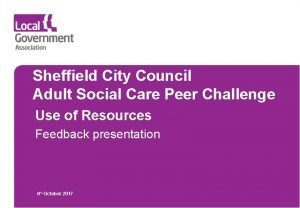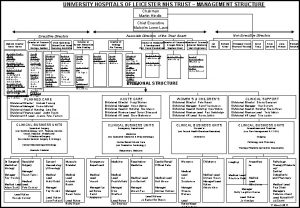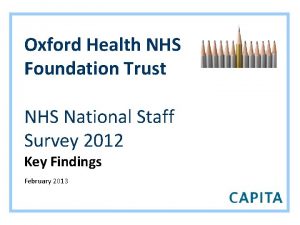Sheffield Health Social Care NHS Foundation Trust Changing











- Slides: 11

Sheffield Health & Social Care NHS Foundation Trust Changing the Narrative with People Who Present in Crisis Across the Acute and Rehabilitation Care Pathway Linda Wilkinson Consultant Clinical Psychologist Kate Oldfield Senior Clinical Psychologist Lisa Keegan Clinical Psychologist Service User Experts – Sheffield Volunteers Sheffield Health and Social Care Foundation Trust

Sheffield Health & Social Care NHS Foundation Trust Narrative for Staff and Service Users Across the Urgent Care Pathway: Themes from Survey and Incident Reports Staff difficulties in making sense of behaviour Incidents of self harm/Ligature substance misuse: inpatient services -assaults from service users to each other and or to staff -can generate fear and rejection in staff teams & Service users. “agree with service users to avoid being shouted at. . or complained about” “worried in case suicide- over protective…”Don’t feel safe unless admitted to the ward” Interpersonal difficulties Housing: financial and social difficulties: concerns about physical health: for some coming into contact with the criminal justice system. Staff and service users feel overwhelmed…”its to much all this, just think cant bear it” Feeling of failure “Backed into a corner … “manipulated …”overwhelmed” Maintaining safety Staff can feel helpless to help: Escalation of risky behaviour and subsequent management-e. g. staff and service users feel angry and frustrated. …. ”blame me for getting angry”. High instance of co-morbid problems Repeat admissions- “care not good enough” staff and service users blaming each other …and teams” …”when something bad happens…messages lost- blame and fear

Sheffield Health & Social Care NHS Foundation Trust BOUNDARY SEESAW MODEL Danger Zone Risky Zone Safety Zone Laura Hamilton (2010) in ‘Using Time, Not Doing Time’ Focus on Culture Change

Historical Factors – Past Traumas – neglect EXIT – seeing eye – caring – cared for supervision/formulation shared view Trigger – Change in Care Team – Loss – relationship breakdown Feels frightened intimidated People speak in an authoritative voice Can’t talk to anyone Withdraw feeling isolated Rebel Not good enough People try to stop me self harming Don’t know what to say – hide away in my room Terrified Vulnerable (little girl) Angry and helpless Critical Controlling Critised Controlled Frustrated Fear Sadness Lack of coordination shared understanding between teams Wanting to do a good job – caring wanting to understand Let down by team Approach staff feel better in the short term Generates worry/concern Seek care through self harm Feel inadequate can’t get my voice heard Needs not met EXIT understanding Teams become controlling and blaming of each other Dismissive not engaged Seeking care and reassurance Team delivering care and treatment – feel anxious stressed ‘worn down’ needing Seek validation from other teams Learn DBT skills/emotional regulation

Sheffield Health & Social Care NHS Foundation Trust � Whole Team approach to Formulation-Feedback from staff focus groups. Not focusing on diagnosis; focusing on service users lives � Empowering the team; being valued, everyone in-putting � Consistency in the approach � Tailoring service to meet individuals needs – holding on to individuals identity � Sharing team decisions around risk, builds confidence � Understanding the meaning in behaviour, understanding your own responses � Builds human connection to our service users

Sheffield Health & Social Care NHS Foundation Trust Builds human connection to our service users � “case formulation makes us look at the bigger picture. Maybe you’re dealing with a crisis where someone is being verbally abusive you’ve got in the back of your mind all these discussions that you’ve had as a group about maybe why they are in that place right now, that it is not personal, its not because of you this happened, and triggered loads of other feelings. . it keeps it in the back of your head so that you are never kind of feeling animosity towards the service user for being aggressive because you’ve got a further understanding of what they’re going through”

Sheffield Health & Social Care NHS Foundation Trust Understanding the meaning in behaviour, understanding your own responses � “Because service users are behaving in ways that elicits a response from you but when you have got that diagram you can see other avenues and you can see why” � “having the team formulation and having like a diagram that explains your own responses so you know that sometimes the feelings that you are feeling are natural…you know where it’s coming from” � “it helps because you feel like you have understood the problem a bit more. . that gives us confidence in what we are doing. . its easier to give our service users confidence”

Sheffield Health & Social Care NHS Foundation Trust WHAT HELPED SERVICE USERS -THEMES FROM THEMATIC ANALYSIS WITH 20 SERVICE USERS ACROSS THE PATHWAY. Shared formulation gave me a sense of hope…feeling like …finally I understand it and there's a way out… “helped me to understand what was going on for my son” Increased understanding provided containment “Not vying for control” –”no Shared approach reduced conflict through mutual and agreed expectations The shared formulation and care plans within and between services so that the Service User did not feel abandoned – “used to feel passed around like a hot potatoes for the first time I wasn’t fobbed off… particularly when I went to A&E, they understood with the diagram and the sheet how to help me’’. mixed messages” – I knew what was expected of me and what I could expect of the staff”…the spikey drawing helped with the cutting and working with staff in all the teams with the drawing…” Managed transitions Clear risk and crisis management led by the service user- communicated with family/others “the spikey diagram. . it was done with me, not done to to all teams me”…”help me feel more in control when everything developing the shared formulation and ways out – using e. g. “DBT skills to self manage gave a new perspective to think about others ways to manage myself”. “helped me and the team to work in a consistent positive way”. was whirling round in my head”…”deciding things together and making sure everyone knew that If I self harmed not to panic and send me to hospital”. helped me to know what to do to help and not feel to scared” Keeping interventions skills based and practical

Sheffield Health & Social Care NHS Foundation Trust Conclusion � Managing the revolving door –whole urgent care system is beginning to learn from and integrate psychological informed care, which has provided containment understanding, and compassionate care in high-risk environments. � Using Emotion Focused Formulation is beginning to change the narrative for service users and staff. � Improves service user and staff’s understanding of patterns in coping – offers hope, control and opportunity for change.

Sheffield Health & Social Care NHS Foundation Trust References � John Ballatt and Penelope Campling 2011. Intelligent Kindness- Reforming the Culture of Healthcare: � Berry, K et al. 2009 A pilot study investigating the use of psychological formulations to modify psychiatric staff perceptions of service users with psychosis. Behavioural Psychotherapy, 37, 39 -48. � Berry, K. , Haddock, G. , Kellett, S. , Roberts, C. , Drake, R. & Barrowclough, C (2015). Feasibility of a ward-based psychological intervention to improve staff and patient relationships in psychiatric rehabilitation settings. � British Psychological Society 2011–Good Practice Guidelines on the use of psychological formulation. � Durrant, C. , Clarke, I. , Tolland, A. & Wilson, H. 2009, Designing a CBT Service for an Acute In-patient Setting: A pilot evaluation study. Clinical Psychology and Psychotherapy. 14, 117 -125. � Clarke I. (2008) Pioneering a cross-diagnostic approach founded in cognitive science. In I. Clarke and H. Wilson (Eds. ) Cognitive Behavior Therapy for Acute Inpatient Mental Health Units; working with clients, staff and the milieu. Hove UK: Routledge. 65 -77. � Ian Kerr, 2009 Cognitive Analytic Therapy for Borderline Personality disorder, SPD Network Meeting Aberdeen 2009.

Sheffield Health & Social Care NHS Foundation Trust v. Thank you for Listening v E mail address v Linda. Wilkinson@shsc. nhs. uk Kate. Oldfield@shsc. nhs. uk
 Western sussex hospitals nhs foundation trust board
Western sussex hospitals nhs foundation trust board Tasmin v barts health nhs trust
Tasmin v barts health nhs trust Adult care sheffield
Adult care sheffield Care value base health and social care
Care value base health and social care Health and social component 3
Health and social component 3 Portsmouth hospital trust values
Portsmouth hospital trust values Occupational health uhcw
Occupational health uhcw Simon sheppard nhs birmingham
Simon sheppard nhs birmingham Portsmouth hospitals nhs trust jobs
Portsmouth hospitals nhs trust jobs Airedale nhs trust v bland
Airedale nhs trust v bland Dr ysr aarogyasri health care trust
Dr ysr aarogyasri health care trust Types of care primary secondary tertiary
Types of care primary secondary tertiary





















